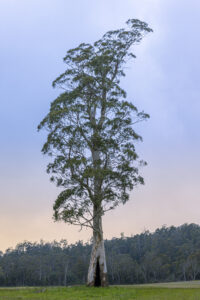Introducing Eucalyptus ovata – Part 1
Introduction
As far as endangered species go in Tasmania, it’s normally the birds and mammals that get most of the attention. We all know about the plight of swift parrots, Tasmanian devils and that a leading cause of a species’ decline is a loss of suitable habitat. What we don’t often think about, is that sometimes the habitat itself is just as, if not more, threatened or endangered.
Black gum (Eucalyptus ovata), while less famous than its blue gum cousin (Eucalyptus globulus), plays an important role in the ecosystem. Unfortunately, black gum forest and woodland is a threatened vegetation community in Tasmania. Black gum forest and woodland is an example of a habitat that has been subject to a drastic reduction in size and distribution, to the detriment of species that rely on this vegetation community.
Vegetation community and ecology
The black gum is a medium sized eucalyptus tree, growing to roughly 30 metres in height. A black gum forest or woodland is any native forest that is dominated by Eucalptus ovata trees of varying ages and sizes, with a diverse understory or smaller trees, shrubs and grasses of many different species. This means black gum woodlands can look very different form one another, with different types of under storeys depending on type of soils, proximity of water and levels of herbivore grazing. The white gum, Eucaluptus viminalis, is a common subdominant, co-dominant or even dominant tree species often found occurring within black gum forest and woodland patches.
It’s widely distributed in Tasmania, more so in central and Eastern regions. Unfortunately, black gum dominated woodland is often small or fragmented, or in degraded landscapes without much understory. Small patches of black gum forest suffer from lower productivity and are vulnerable to weed invasions, overgrazing from livestock and deer, genetic pollution from commercially grown Eucalyptus nitens and are more exposed to dieback in the dry season.
History and protection
Black gum forest communities were much larger, widespread and better connected to each other prior to European settlement. Unfortunately for black gum forest and woodlands, and the species that rely on them, early settlers favoured the same type of landscapes favoured by black gum vegetation communities. Fertile areas close to rivers and flatter regions like the Northern Midlands that were once home to larger black gum dominated woodlands were prime real estate for farmers and graziers. This means that the current distribution of black gum forests in Tasmania is a fraction of what it was prior to colonisation. Fortunately, these remaining patches are now listed as a threatened vegetation community and are protected under state and Commonwealth legislation. Eucalyptus ovata itself is listed as vulnerable by the International Union for Conservation of Nature and its population trend is decreasing.
Black Gum Conservation Group & How to Help
The Black Gum Conservation Group (BGCG) is a newly formed not-for-profit group working hard to protect this vegetation community. The BGCG’s primary objective is to increase the area of black gum forest and woodland in Tasmania as well as protect existing forests. The BGCG aims to re-establish black gum forest and woodland in suitable areas through revegetation projects on public and private land. The BGCG is entirely volunteer based, therefore the more hands on deck, the faster we can get more black gum into the ground, for the sake of our unique Tasmanian forests and the threatened species that rely on them. To get involved, visit the BGCG webpage here and sign up to receive updates on future volunteer opportunities.
Written by Jason Graham, B Environment & Wilderness Studies
